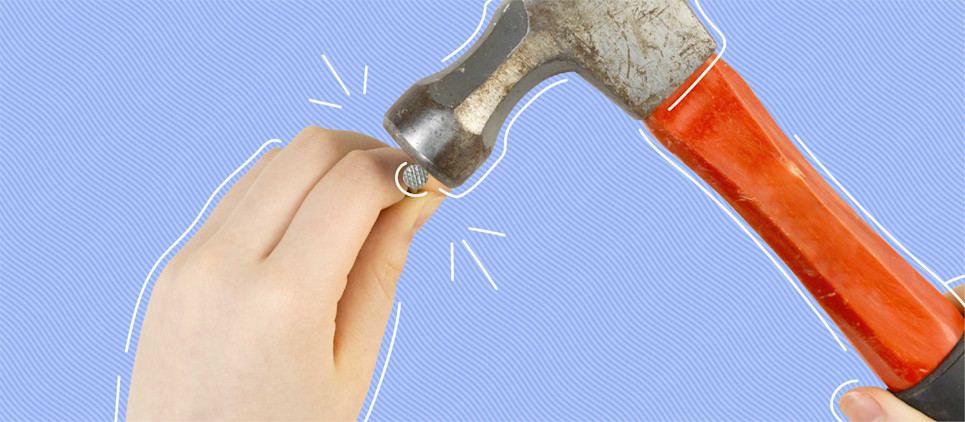How to find wall studs—and why you need to in the first place
Art, mirrors, wall-mounted shelves: you’ve got the inspiration, but in practice, hanging them takes work. Just putting a nail in your drywall isn’t going to do the trick—instead, you’ll just end up with the haunted-house-effect of things falling to the ground when you least expect it.
To securely hang weighty things like large framed pictures, you’ll have to find a stud. Yes, there’s a tool for that, but there are also several ways to do it the old fashioned way. Read on to learn everything you need to know about spotting wall studs, with or without a stud finder.

Table of contents
What is a wall stud? 6 ways to find a wall stud1. Use an electronic stud finder2. Follow the outlets3. Tap it out4. Break out the magnets5. Shine a light6. Trace your trimWhat is a wall stud?
Studs are vertical 2 by 4 inch beams that support the frame of your home. You can find them behind your drywall, usually spaced 16 or 24 inches apart. Since studs are made of thick and sturdy wood or metal, they can securely hold screws better than wall materials like drywall.
Typically, studs are measured “on-center,” which means that you can measure from the center of one stud to the center of an adjacent stud. This standardized spacing was developed by builders so that drywall would be evenly supported. Nails or screws are typically used to attach drywall to studs.
6 ways to find a wall stud
In most homes, you can easily find studs by using a tape measure, a flashlight and a magnet. Another option is to use electronic stud finders. Trying out more than one method will help you zero in on your stud’s location with greater accuracy.
Once you’ve found your stud and are ready to go in with a screw or drill, turn off the power via your circuit breaker for safety—in case you hit a wire behind your wall.

1. Use an electronic stud finder
As its name would suggest, an electronic stud finder finds studs. You can find them in hardware shops or online, and they cost anywhere between $10 to $50. Most models can differentiate between wood and metal studs, and they can alert you to the presence of electrical wires.
Stud finders aren’t as accurate when it comes to identifying studs through plaster walls, so if you have plaster walls, you should use the gadget along with other methods (like those listed below) to get the most accurate read.
To use an electronic stud finder, hold it flat against the wall, about a foot to the left of where you ideally want to drill. Slowly slide the stud finder to the right. When it lights up or beeps, retrace the last few inches to ensure you know where the alert occured, then mark that spot with a pencil. This is the left side of your stud.
To find the right side, repeat this process, moving the stud finder to the left and marking the point where the finder lights up or beeps.

2. Follow the outlets
Light switches or outlets are typically fastened to studs, making them an excellent stud guide. Remove the outlet or light switch cover, peering inside with a flashlight until you spot which edge of the stud is attached to the box. From there, measure out 3/4 of an inch to locate the center of the stud.

3. Tap it out
Another way to check for studs is to employ the knock test. Unroll a tape measure from a corner of your home and mark the wall with a pencil at 12, 16 and 24 inches, then knock the wall at each point. Areas without studs give off a low, hollow sound. Tapping a stud, however, produces a higher tone and more solid sound.

4. Break out the magnets
Got a collection of fridge magnets? Pick the strongest one and use tape or string to dangle it along the wall, allowing it to pull you towards the nail in your stud. Once your magnet is pulled to the nail, measure 16 or 24 inches out to find the rest of the studs in your room.

5. Shine a light
Raised or sunken imperfections running vertically on drywall can indicate fasteners were used to secure the panels to the studs. These fasteners can give you a solid idea of the center of the studs. Using a flashlight

6. Trace your trim
Your baseboard is likely attached to studs, and if you follow it carefully, you should be able to find spots where it was nailed. These holes will probably look more like dimples, since they’ve already been filled with caulk and painted over, but you might be able to spot them if you look close enough. Next, trace a vertical line up your wall with a pencil, knocking along the line to hear if the sound is hollow or solid and using a magnet to spot your stud’s nail.
The more methods you try, the greater the chance you’ll be able to safely and securely decorate—and your walls will thank you.
Bungalow offers private rooms in shared homes that are more affordable than solo housing options in the same neighborhoods—which means more money for wall art. Wifi, utilities, and monthly cleaning are set up before you move in, so that communal living is seamless. Find a Bungalow near you.
Ready to find your next home?
Move-in ready homes and a built-in community so you can feel at home, together — wherever you are.
Suggested articles



